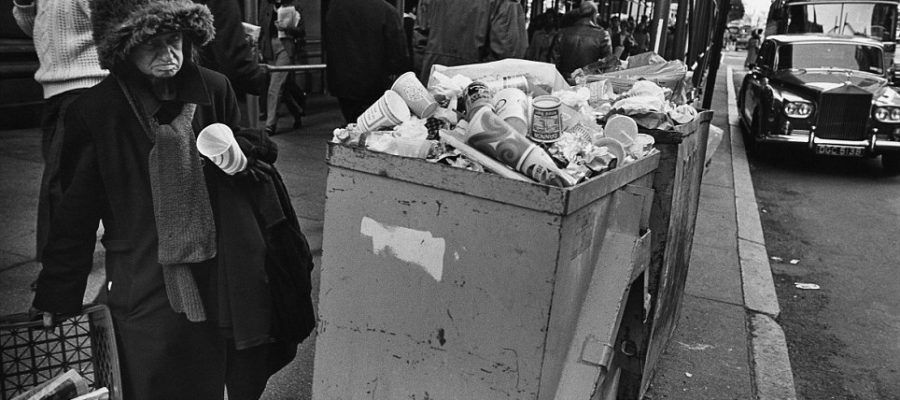Artists often begin their careers by imitating the work of others. The act of imitation in this context is not a form of theft, but rather, a means for the artist to develop his skill until he comes to maturity. With this thought in mind, I can’t help but think of Detroit as an adolescent imitation of a Hieronymus Bosch painting. There are no avian torturers with ominous beaks but there are plenty of corpses. There are hollow, flaking buildings with graffiti scrawled over them and weeds growing through the pavement. There are the needles, the crack pipes, the spent shell casings, and the thousands of shattered windows. I promise this isn’t an attempt to make you feel sorry for inner-city black children. There will be no appeals for you to donate to a charity at the end of this article. My intention is rather different: I’m trying to put forward the claim that good government, like good art, is rooted in the strength of its imagery.
One has plenty of choices for good imagery in government. One might think of the white columns of the Acropolis or the mirrors of Versailles or the old palaces of China with their silk banners and arched roofs. Whatever a man imagines, suffice it to say, he won’t be thinking of a place with crackheads mooching outside of a liquor store.
When a sensible man is told to picture something that resembles good government, he doesn’t think of Detroit. The dilapidated buildings alone would be enough to tell him that things are poorly run there.
There are some in the social sciences who would agree with this. In 1982, two sociologists named Wilson and Kelling published a paper on what has come to be called the “broken windows theory” of criminology. If an abandoned building at the end of the block has a broken window that doesn’t get repaired, it can invite more broken windows. The shattered glass in turn invites the local graffito to spray his girlfriend’s name over the wall. The accumulated graffiti invites squatters. The squatters inevitably draw in the prostitutes, the crack fiends, the gang wars. As the dominoes fall, one small sign of decay invites a dozen others, not just by attracting the kind of people who are comfortable with disorder, but by driving out those who are inclined to be orderly.
On the whole, it’s good advice not to pay much attention to sociologists. This is especially true of those who wear woolen pullovers, speak with nasally condescension, and work for universities in New England. But unlike most theories dreamed up by academics, the broken windows theory has been put into practice and it worked.
In 1993, New York City mayor Rudy Giuliani appointed an acolyte of Kelling, a man named William J. Bratton, to serve as police commissioner. Together the two men knuckled down on public drunkenness, graffiti, fare dodging, illegal nightclubs, and panhandling. They went after everything that had made New York famous. As it turned out, the new policy worked well: not just petty crime, but all crime in New York City declined for more than ten years.
This fact has ruffled the feathers of more than one bugman commentator. At first glance, a leftist ought to love the broken windows theory because it appears to render a man’s willpower inert. Men seem to be mere products of their environment; the greater the number of derelict buildings, the greater the number of black men in jail who, their mothers assure the interviewer, could have been brain surgeons if things had just been a little different. One of the most common dogmas of the left is their pig-headed belief that men are born a blank slate, a tabula rasa, and so if a man is evil, it’s due to his life’s circumstances. So why isn’t the left fawning over the brain child of Wilson and Kelling?
The first reason is one that I alluded to already in this article. The theory doesn’t stipulate that the drafty windows and dilapidated buildings lead to crime; it could just as easily be assumed that those who are criminally inclined will be attracted to such places. It’s the pollen that lures the bees, so to speak.
Another, more cynical view which is not at all contradictory with the others, is that by being stricter on petty crimes, the police are removing violent criminals from the streets before they are able to commit a more serious crime. This argument, however, smells faintly of eugenics. It assumes that criminals are predisposed to crime by their nature, and so those who are willing to break minor laws are also very likely to break more serious laws. To anyone who believes in blank slate consciousness, this argument must be rejected outright. The left cannot embrace it.
Another reason is that the broken windows theory vindicates norms that the left would rather not see vindicated. Graffiti, like those tattoos on the neck of your local Whole Foods cashier, is not just another form of cultural expression: it’s a sign of a disorderly mind, the kind of mind that brings about social degradation. The squeegee man on the corner isn’t just trying to make ends meet, he’s most likely a crackhead looking for a quick fix. The woman high on ecstasy in a nightclub bathroom probably ought to be settling down with a man, having kids, and tucking them in at that hour of the night. The theory makes it clear that communities work best with traditional values, not the kind of values pushed by those who are inclined to social justice. Family, faith, social clubs, fresh-cut lawns, open windows and unlocked doors — the stuff dreams are made of, the treasures of tradition.
The final reason the left hates the broken windows theory is that they are spiteful people: Rudy Giuliani was a Republican. The left hates it when the other side does well because, to the ideologue, his struggle has to be all-or-nothing.
Needless to say, a battalion of subversives, doctrinaire professors, and know-nothing journalists have denounced the broken windows theory. It’s racist, of course, because it affects black neighborhoods more than white ones. It’s elitist. It’s bigoted. It’s literally Hitler. One of their more humorous claims is that cracking down on petty crimes works briefly but then results in a defiant upsurge in convictions for those crimes later.
Singapore canes people for spitting excessively on the street, and to date it has not reported any spates of defiant saliva-chuckers. Being hit by a rattan cane hurts, after all. Nor do I imagine that Pyeongyang has had to arrest many people for loitering. No, strict laws, strictly enforced don’t lead to sudden and mysterious spikes in crime. That’s more likely to be seen with laissez-faire law enforcement.
It should be clear by now that the left can’t endorse the broken windows theory without violating its own tenets but what value is there in it for the right? I personally have no special concern for New York, nor do I have any interest in cleaning up black neighborhoods. I imagine most people on the right would feel the same way. The broken windows theory is fascinating to me, however, because it exemplifies a principle of human nature that is often overlooked in the post-1945 West. For a government, good imagery is not about conveying abstract principles like peace, toleration, and compassion: it’s about conveying authority. Good optics for the government, then, is any aesthetic where the government recognizes itself as the foremost authority of the land and is proud to serve in that capacity.
A police station with flaking paint and prostitutes milling around outside is a station that sends one very clear message to the world: it’s signaling a lack of self-belief. Parents who ask their children how they should be punished say one thing to their children: they are saying that they don’t believe in themselves.
It becomes clear after some reflection that the left and right differ in large part on the level of their self-confidence. The right-winger is more comfortable with his own authority and is therefore also more comfortable with a government that recognizes its own importance. It’s telling that most Americans who call themselves libertarians will sing the Star-Spangled Banner at sporting events and fly the American flag outside of their homes. No matter how often they speak of individualism, or of spurning the collective, they are by nature a patriotic group of people. They instinctively support their country when they feel like it’s doing a good job of supporting them.
Left-wingers, on the other hand, are a very different breed. Leftist philosophy is in the main a nagging, impetuous opposition to authority. It springs from a mind that is not comfortable with individual authority and therefore seeks a consensus to exert power over whatever the prevailing authority happens to be. The consensus is not due to any particular love of democracy; consensus is, in this case, just a means for them to exert power and still feel safe while doing it. It’s no coincidence that the left uses the dialectic to build consensus around the underdog; it tugs on the heartstrings of those who are inclined to be emotional and then suddenly the left is able to swing the majority in its favor. It’s always the same ethic, re-imagined and reinterpreted for the times, but ultimately the same: the haves versus the have-nots.
The aristocrat, the have, stomps his shiny boots on the peasant, the have-not. The white man takes his whip to the black man. The straight professor oppresses the non-conforming, blue-haired feminist. This theory is all smoke and mirrors but it makes for good theater.
The performance is so convincing in fact that the left must by necessity doubt all authority, even its own. If one of these have-not groups were to seize power the clockwork would spin mechanically to the next target. If a black nationalist party murdered or frightened away every white man in South Africa, the left would immediately begin with the rich-black versus poor-black dichotomy; or maybe dark-blacks versus light-blacks. If the blue-haired feminists took over at Yale the various forms of gender non-conforming students would turn against each other, like those with blue hair versus those with braids. It never ends. It never relents.
If the problem is always the same, the solution is the same, too. Egalitarianism, the great cudgel of the left, is always there to break up good order and harmony. When the left makes passionate appeals to equality, what it really hopes to achieve is a political change of hands. It’s simple realpolitik. Pull back the silk screen that the left uses to shield their ideas and you find nothing but knives and chains.
The leftist reverence for pacifism is a good example of this. The liberals, the socialists, the hard-line communists, that is to say, the entire spectrum of the left promotes pacifism as a means to achieve world peace. The problem with this sort of posturing, however, is that the left never begins by promoting disarmament among nations that rival their own. They only want to disarm their own nation and therefore undermine its government’s authority.
This pattern holds true for most of the items on the left’s agenda. The leftists pretend to champion the cause of social justice and they are willing to uproot justice itself in the pursuit; thus, the left agitates for anti-discrimination laws but only to the extent that they protect the underdog ethnicity which they prefer. They refuse to acknowledge any law that applies these rules equally to all citizens, especially to whites. By being fair and gracious, they would disrupt the dialectic that keeps them in power. So, too, with their posturing on feminism where they claim to support women’s rights but only to the extent that they can keep the fires of the gender dialectic stoked: if a woman chooses to forego a career for the sake of her children or if she dares to enjoy things like cooking and sewing, watch how these same feminists wag their fingers and mock the poor housewife.
The left’s political platform is a pattern repeated in concentric, overlapping circles: there’s an opposition to authority followed by a redefining of who or what the authority is, and then a new opposition to this new authority. If some readers think this is hyperbole, if they claim that I’m being unreasonable or unfair to the left, I would encourage them to take a hard look at Detroit. Check any major city in America. Desegregation, forced busing, racial quotas in work and school – the black-white dialectic has helped tip the political balance in favor of the left and it has also turned our cities into a living catastrophe.
It’s the same illness, the same medicine, and the same quack doctor rushing there to treat it. What chance does America stand when this is the same disease that carved up the British Empire and murdered the Romanovs?
There seems to be no easy answer to this question. But I can begin to see a solution, dimly, somewhere out there in the misty regions of history where Diocletian meets Rudy Giuliani.
Maybe it’s time to set aside our apologies and our tolerance. Maybe it’s time to start cleaning up our streets again.
-By Fritz Pendleton

Visit The American Sun at The American Sun






Broken Window theory is rejected and hated by the left for a far more fundamental reason: it’s True. Not just empirically, demonstrably factual, but True. It isn’t original, either: Wilson and Kelling observed what we Christians were told some twenty centuries ago: in Matthew 25:14-30, we find broken window theory first applied:
“Well done, thou good and faithful servant: thou hast been faithful over a few things, I will make thee ruler over many things: enter thou into the joy of thy lord.”
Who fails in little things will make calamity of great things. So, “which hath shall be given; and from him that hath not, even that he hath shall be taken away from him. But those mine enemies, which would not that I should reign over them, bring hither, and slay them before me.”